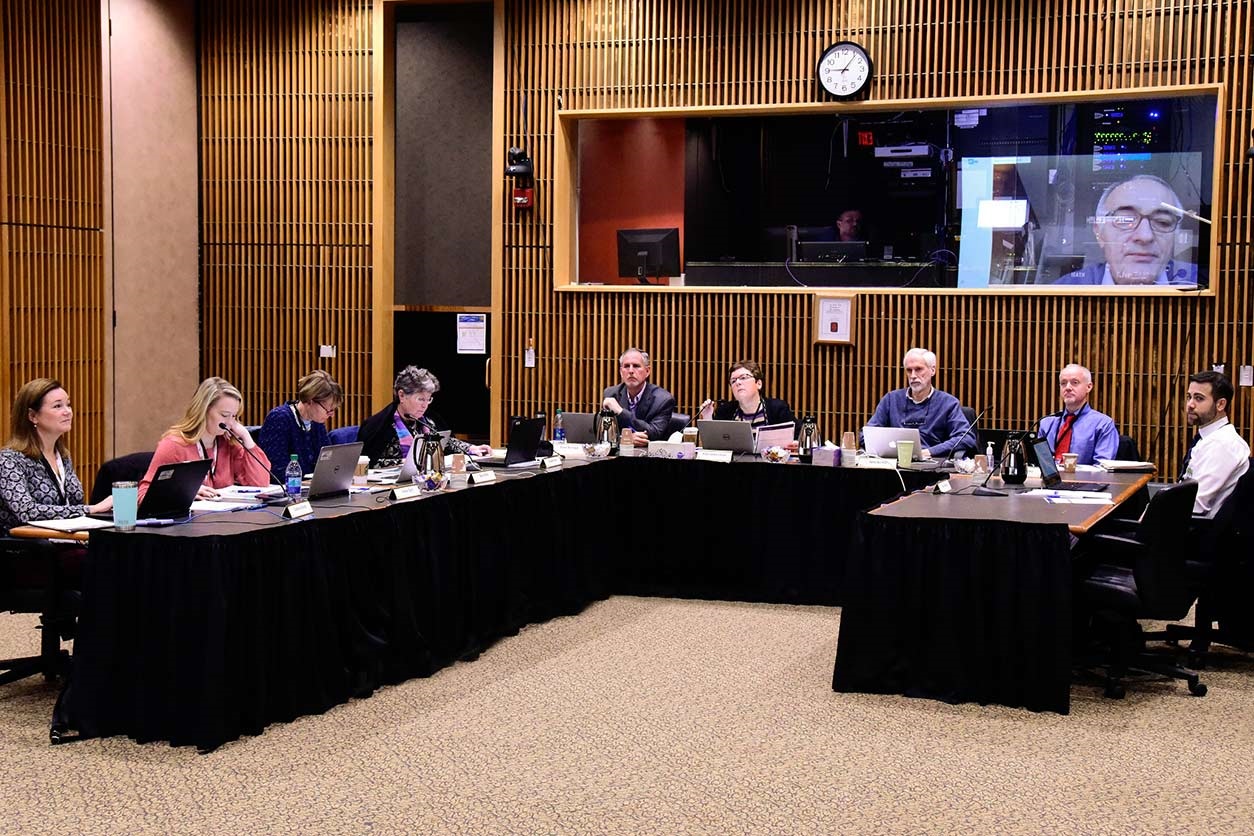 Factor-Litvak briskly moved the proceedings along, even with procedures for 27 votes. (Photo courtesy of Steve McCaw)
Factor-Litvak briskly moved the proceedings along, even with procedures for 27 votes. (Photo courtesy of Steve McCaw)An international panel of experts met February 4 to review conclusions by scientists in the National Toxicology Program (NTP) regarding the highly toxic organophosphorus nerve agent sarin. The peer reviewers, from as far away as Israel and England, met via WebEx and supported the draft of NTP hazard conclusions on the long-term neurological effects of exposure to sarin.
Pam Factor-Litvak, Ph.D., from Columbia University, chaired the peer review proceedings and was the only panel member physically present at NIEHS for the meeting.
Regarding health effects in the first seven days after exposure, the experts agreed that there is sufficient evidence to classify sarin as known to be a neurological hazard to humans. That is NTP’s highest hazard rating.
The panel also accepted the longer term hazard conclusions included in the draft monograph. The document is the product of a systematic review of human and animal health effects data reported in scientific literature. When neurological symptoms were seen weeks or years after exposure, the evidence connecting sarin to the symptoms was weaker, but still sufficient to classify sarin as suspected to be a neurological hazard to humans in the long term.
Findings to inform treatments
The NTP Office of Health Assessment and Translation (OHAT) launched the project after sarin was nominated by a National Institutes of Health program called Countermeasures Against Chemical Threats (CounterACT). The CounterACT program requested a systematic review of potential long-term neurological effects of sarin to inform decisions about the need to develop treatments.
Although immediate effects of sarin are well known, there is less certainty about effects days, weeks, and years after exposure. The peer review focused on the evidence of long-term neurological effects, which were defined as damage observed or reported more than 24 hours after exposure.
 Acting OHAT Director Andrew Rooney, Ph.D., handled the presentation tasks for several sections of the draft monograph. (Photo courtesy of Steve McCaw)
Acting OHAT Director Andrew Rooney, Ph.D., handled the presentation tasks for several sections of the draft monograph. (Photo courtesy of Steve McCaw)The strongest evidence for effects of long-term exposure to sarin was found for four main areas.
- Changes in levels of the enzyme cholinesterase.
- Effects on eyes and vision.
- Effects on learning, memory, and intelligence.
- Changes in nervous system tissues.
The NTP team discussed other outcomes that did not contribute to hazard conclusions, as well as the process of combining animal and human evidence to reach hazard conclusions.
“It is really a remarkable work,” said Arik Eisenkraft, M.D., from the Hebrew University Faculty of Medicine in Israel. “I appreciate how thorough you were with the data.”
The peer review committee voted on the animal and human conclusions for the three time periods after exposure — initial, intermediate, and extended — for each of the four main effects. They agreed with the NTP conclusions in almost all cases, including the ultimate hazard identification conclusions.
 The sarin peer review was a virtual meeting, with panelists attending from Israel, Europe, and the United States. Presenters, NTP personnel, and chair Factor-Litvak were present in the meeting room (Photo courtesy of Steve McCaw)
The sarin peer review was a virtual meeting, with panelists attending from Israel, Europe, and the United States. Presenters, NTP personnel, and chair Factor-Litvak were present in the meeting room (Photo courtesy of Steve McCaw)More research needed
The immediate neurological effects of acute sarin exposure are well known and include difficulty breathing, seizures, paralysis, and death. These effects, along with impacts observed 1-7 days after exposure, are largely due to decreased levels of cholinesterase.
 “Transparent peer review is an important part of the NTP program, to ensure that our products are impactful, defensible, robust, and rigorous,” said NTP Associate Director Brian Berridge, D.V.M., Ph.D. (Photo courtesy of Steve McCaw)
“Transparent peer review is an important part of the NTP program, to ensure that our products are impactful, defensible, robust, and rigorous,” said NTP Associate Director Brian Berridge, D.V.M., Ph.D. (Photo courtesy of Steve McCaw)This essential enzyme is critical for normal nervous system function and helps nerve signals turn off at the appropriate time. Without it, nerve signals stay on permanently, causing nerves to keep firing and muscles to remain contracted. This leads to paralysis and respiratory failure.
Although cholinesterase suppression lingers, evidence suggests that it gradually subsides, while other neurological symptoms become more prominent, including effects on learning and memory, the eyes, and changes in nervous system tissues.
As several panel members observed, the draft monograph presented a review of the evidence for the main effects and highlighted the gaps in knowledge and need for more research about sarin’s long-term neurological effects. One panel member, Frederic Baud, M.D., from the Universite Paris Diderot in Paris, suggested that it would be helpful to delineate the research gaps in the final version of the monograph.
NTP will post slides from the presentations on the sarin meeting webpages.
(Ernie Hood is a contract writer for the NIEHS Office of Communications and Public Liaison.)







